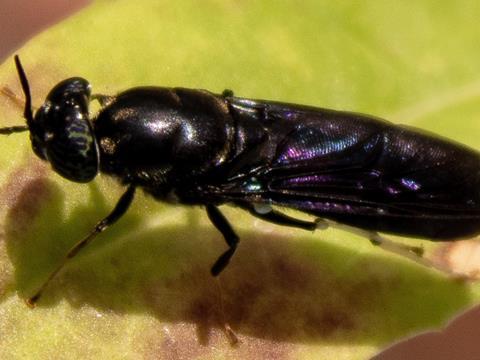
Researchers at Texas A&M University are extracting chitin from the carcasses of black soldier flies in an effort to produce degradable bioplastics while avoiding competition with other uses.
Presented at ACS Fall 2023, the autumn meeting of the American Chemical Society (ACS), the solution aims to utilise waste products left behind after farming black soldier flies. While their larvae are raised for animal feed and waste consumption due to the various proteins and nutritious compounds they contain, adult flies have a short life span after breeding.
Principal investigator Karen Wooley, Ph.D., has identified that the carcasses contain high levels of chitin – a non-toxic, biodegradable, sugar-based polymer that strengthens the exoskeletons of insects and crustaceans.
Shrimp and crab shells are already utilised in the packaging industry as sources of chitin, but with the isolation, purification, and conversion of insect-derived chemicals into functional bioplastics having competing applications, the use of adult flies rather than larvae prevents any crossover with other applications, such as animal feed.
“For 20 years, my group has been developing methods to transform natural products — such as glucose obtained from sugar cane or trees — into degradable, digestible polymers that don’t persist in the environment,” says principal investigator Karen Wooley, Ph.D. “But those natural products are harvested from resources that are also used for food, fuel, construction and transportation.”
Graduate student Cassidy Tibbetts has been applying ethanol rinses, acidic demineralisation, basic deproteinisation, and bleach decolourisation to extract and purify chitin powder from the carcasses. As well as removing the yellowish colour and clumpy texture from traditional chitin, the process is also thought to avoid potential dangers surrounding seafood allergies that arise from other sources.
“We’re taking something that’s quite literally garbage and making something useful out of it,” Tibbetts explains.
Meanwhile, fellow graduate student Hongming Guo has worked to purify the fly chitin into the polymer chitosan – a process that involves stripping chitin’s acetyl groups to expose, functionalise, and crosslink the chemically reactive amino groups. In doing so, bioplastics can be created.
One such bioplastic is a superabsorbent hydrogel, a 3D polymer network that can reportedly absorb 47 times its weight in water in one minute. It is also said to be biodegradable, meaning that its molecular components can gradually be released as nutrients for crops.
The team now plans to break down chitin into its monomeric glucosamines, or small sugar molecules that can be used to produce polycarbonates, polyurethanes, and other bioplastics to replace petrochemical-based alternatives. Proteins, DNA, fatty acids, lipids, vitamins, and other compounds found in the fly carcasses are also hoped to be used as starting materials in the near future.
All the products made from these building blocks will be designed to degrade or digest upon disposal – hoping to contribute to a circular economy and prevent the exacerbation of the plastic pollution crisis.
“Ultimately, we’d like the insects to eat the waste plastic as their food source, and then we would harvest them again and collect their components to make new plastics,” Wooley concludes. “So the insects would not only be the source, but they would also then consume the discarded plastics.”
In similar news, scientists at the Northeast Agricultural University in Harbin, China have unveiled nanofibre active food packaging made from chitosan/chitin and scallion flower extract. The chitin is said to extend the shelf life of bananas compared to pure PE films, as well as improve the film’s barrier, mechanical, antimicrobial, and antioxidant properties.
Additionally, new separation facilities capable of processing shellfish and deriving chitin for use in the pharmaceutical, cosmetics, and food industries are under development in a collaboration between Wood and CuanTec.
If you liked this article, you might also enjoy:
The Lidl approach to packaging sustainability
How did Brazil achieve its 100% aluminium can recycling rate – and can it be replicated in the EU?
Experts have their say on the EU’s Packaging and Packaging Waste Directive revisions
A deep dive into the most important packaging sustainability trends and solution












No comments yet